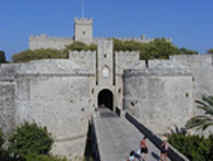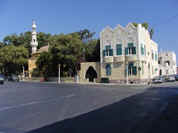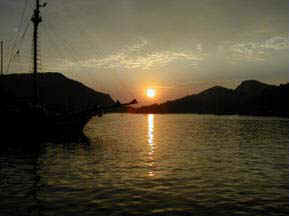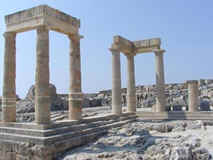 |
|
||
 During the 14th and 15th centuries the Knights of the Order of St. John extended the Byzantine city and reinforced its fortifications creating the medieval town of Rhodes. Of note is the architecture in the gothic style developed in Provence at the Papal Court of Avignon (1309-1424) with which the Knights maintained close ties. During the 14th and 15th centuries the Knights of the Order of St. John extended the Byzantine city and reinforced its fortifications creating the medieval town of Rhodes. Of note is the architecture in the gothic style developed in Provence at the Papal Court of Avignon (1309-1424) with which the Knights maintained close ties.Eleven gates provided access to the city which is divided into two parts: The Collachium, where the Knights resided - the most impressive buildings from that time are located here: the Grand Master's Palace, the Infirmary and the Langues - and the Burgo, the main town. The Old Town, as the locals call it, is today one of the best preserved fortified medieval towns and has been listed by UNESCO and a world cultural heritage monument. Walking down its paved streets, admiring the imposing Knightly buildings, the walls and their dry moat and the bastions, the Byzantine churches and the mosques, the squares, gardens and courtyards of houses, the visitor feels that time has stopped while at the same time discovering that this unique town is still living, full of surprises and just asking you to explore it. The Knights' Street (Odhos Ippoton) is 200 m long and 6 m wide. It was the main official street connecting the religious and political centre of the fortress, in other words the Catholic Cathedral (Panaghia Kastrou) and the Palace of the Grand Master. Along its length are the most important public and private buildings erected by the Knights. Here, with few exceptions, is the accommodation for the Knights, the "Langues", the national divisions of the Order of the Knights of St. John. The street is inclined and unusually for a medieval city completely straight. That is one indication that it was first marked out in antiquity. This was retained by the Knights precisely because the strict linear layout suited them and the new political importance they attached to it. Visit the Clock Tower built in 1851 which was once used as lookout post. It has a small collection of archaeological finds discovered there. The view of the Old Town from the tower is breathtaking. Panaghia Bourgou is a late gothic church dating from the 14th century. It was bombed during World War II and today the three apses of the sanctuary are what remain. Sokratous St. ends in Ippokratous Square. It is the main commercial street in the Old Town. Around the square with its large fountain are many bars, restaurants and nightclubs. Of the many impressive mosques in the Old Town the Suleyman Mosque is truly noteworthy. The present-day building was constructed in the 19th century on the site of an older one which tradition says was erected by the town's conqueror Suleyman the Magnificent. Note the intricate marble entrance which comes from a grave monument from the time of the knights. In Dorieon Sq. lies Retzet Pasha Mosque. New Town  The Temple of Aphrodite from the 3rd century BC. Its ruins were unearthed in the heart of the new town between Mandraki and Akandia Port in Symi Square. The Temple of Aphrodite from the 3rd century BC. Its ruins were unearthed in the heart of the new town between Mandraki and Akandia Port in Symi Square.Murat Reis Mosque with its elegant minaret lies near the Prefectural Building. It is built on the site of Aghios Antonios Church next to the Knight's Cemetery. The Turkish cemetery contains the tombs of exiled Turks, an admiral of Suleyman II's fleet in a round mausoleum and a poet banished by the Sultan for his sarcastic poetry. In the square around the mosque the ruins of the ancient walls have been found together with inscribed stone balls marked with their weight. They begin at 5 mnes and reach 10 talents (2 to 261 kilos approximately). From the type of letters the balls have been dated to the famed siege by Dimitris Poliorcetes. Aghios Nikolaos lighthouse is a fortress at the end of the jetty with the same name where the deer statutes stand at the entrance to the port welcoming visitors to the island. At the other end are three windmills. The first houses the offices of the Army Hydrographical Service where maritime maps can be purchased. The second from the 15th century operates as a museum. One can see the grinding mechanism while the third houses a travel agency. Aghios Stefanos Hill also known as Monte Smith after an English admiral of Napoleon who called at the island in 1802. In the well laid out and verdant archaeological park are the surviving remains of a 3rd century BC Stadium where the Alies Games were held, the largest celebration for the Ancient Rhodians in honour of the god Helios. Next to the stadium a small, marble open-air theatre has been restored and is used for musical performances just like in antiquity. At the peak of the hill is the temple of Apollo Pythia, protector of the city. From here the view over the town and the sea is panoramic and the sunset enchanting. The tombs of St. John are in the central part of the extensive Rhodian necropolis. Important monuments are the large corner tomb complex with domed graves, the group of domed graves crowned by a monument with triglyphs and metopes and the tomb carved into the rock with a monumental gateway. Of most interest is the underground quarry into whose tunnels grave chambers were dug. LINDOS
|
||







